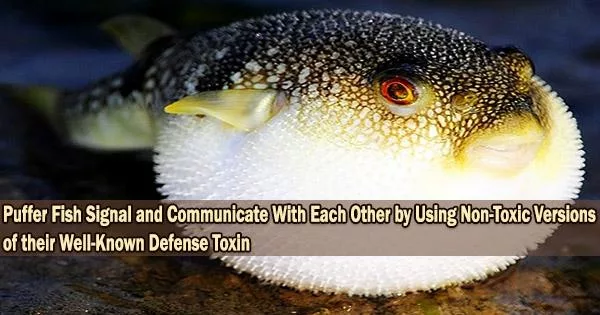Fugu, a prized ingredient in Japanese cuisine, has a poison that can be fatal. A person who consumes puffer fish that has been improperly prepared could get food illness and pass away very quickly. Because the fish’s liver and ovaries contain the potent neurotoxin called tetrodotoxin (TTX), such a horrible incident is possible.
Although its function is unknown, puffer fish also possess non-toxic TTX analogs. Now, scientists from Nagoya University in central Japan have postulated that puffer fish employ these toxin analogs to communicate by smell in a recent study published in Scientific Reports.
The team utilized a grass puffer (Takifugu alboplumbeus), a type of puffer fish, to carry out their research. As bycatch that consume bait and snare fishing lines, grass puffers are a concern for many recreational anglers in Japan.
However, due to their attractiveness, many people exhibit sympathy for them, and some even keep them as pets. In the early summer, on the evening of high tide, grass puffers congregate at a particular location and spawn in large numbers.
Since childhood, Associate Professor Hideki Abe from the Graduate School of Bioagricultural Sciences was delighted by the grass puffer’s “charming appearance.” But as a biologist, he was more intrigued by their spawning behavior.
“I was fascinated by the hypothesis that their toxin may be involved in their spawning behavior as a pheromone,” he explained. Chemicals known as pheromones are used to influence the behavior of other members of the same species and are detected by fish using their olfactory capabilities.
Additionally, the stored TTX and TDT in grass puffers are localized in their skin, liver, and ovary. The TTX released from the ovaries and eggs of the females during spawning may serve to protect the eggs from predators. Meanwhile, TDT released from the skin and ovaries of the females, along with TTX, may attract males.
Professor Hideki Abe
The grass puffer fish, like other puffer fish, builds up the neurotoxic TTX to deter would-be predators. However, grass puffers also collect 5,6,11-trideoxyTTX, a non-toxic version of TTX (TDT). Why pufferfish should accumulate a non-toxic form has scientists puzzled.
To better grasp this phenomenon, a team of Nagoya University researchers led by Drs. Abe, Adachi, and Nishikawa, and their graduate students Yoshihisa Noguchi, Keigo Matsutani, Takehisa Suzuki, Ryo Sakakibara, and Ryota Nakahigashi of the Graduate School of Bioagricultural Sciences, investigated the compound. They discovered that TDT attracts other grass puffers and discovered the olfactory sensory cells that are responsible for this.
The electroolfactogram, a tool that monitors excitations of the olfactory epithelium, the tissue that reacts to scents, was used by the researchers to evaluate grass puffers. Surprisingly, scientists found that the puffer fish’s olfactory epithelium responded to its non-toxic analog, TDT, instead of the poisonous TTX.
TDT appears to operate as an odorant that attracts grass puffers, as indicated by the discovery of olfactory sensory cells that particularly respond to TDT through immunohistochemical staining.
They then put grass puffers in a fish tank and introduced TDT to just one side of the tank to show how enticing it is. The grass puffers congregated in the area of the tank where the chemical was added in response to it.
“This result was unanticipated, since previous studies had assumed that TTX was the pheromone-like substance used by grass puffers,” explained Abe. “The TTX used in earlier studies was derived from living organisms and had low purification; therefore, we assumed that it might not only contain TTX but other analogs, including TDT, which might have actually induced the odor response.”
Long-held ideas about the function of TTX in pheromone signaling in puffer fish may be disproved as a result of their study using pure TDT.
“Prey animals contain both the toxin and its analog, so grass puffers may use the smell of TDT as a signal to find prey animals bearing TTX, such as flatworms, starfish, gastropods, and skeleton shrimp,” Abe continued.
“Additionally, the stored TTX and TDT in grass puffers are localized in their skin, liver, and ovary. The TTX released from the ovaries and eggs of the females during spawning may serve to protect the eggs from predators. Meanwhile, TDT released from the skin and ovaries of the females, along with TTX, may attract males.”
“Our results provide a new perspective on the use of TTX and its analogs by toxic puffers,” Abe concluded. “They are the first clarification of the biological functions of the non-toxic analog and are expected to have a meaningful impact on research on the toxification mechanism and reproductive behavior of pufferfish.”
















